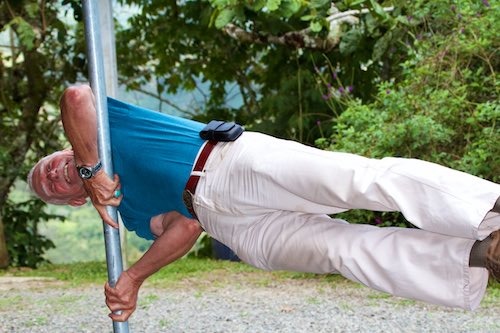We seem to have been successful in using hyperbaric oxygen therapy for more than 40 years. Yet we still don’t know if it works and for what conditions.
Many of our doctors use it to cure chronic diabetic foot ulcers that otherwise could lead to amputation. Since these ulcers are a common complication of diabetes, and when you lose a foot your life will be so seriously impacted, this therapy, known as HBOT, is something we need to carefully consider.
I have been convinced that the use of hyperbaric oxygen might offer many benefits ever since I visited an 82-year-old man named John Erb in Costa Rica two years ago. He is an expatriate American who took me inside his hyperbaric oxygen chamber and showed me to what he attributes his strength. I took the photo below, as I wrote in my photo essay “Rancho Naturalista,” the fantastic ecolodge that he owns.

This 82-year-old Man Attributes His Strength to HBOT (Note that I Cut Off His Feet but Only in This Photo)
HBOT is widely available in North America where we have more than 300 registered facilities. It is typically 15 to 30 sessions of one to two hours during which you breath concentrated oxygen at a pressure that’s higher than that at sea level.
But the use of HBOT for chronic foot ulcers remains controversial. Its use in diabetic foot care was the principal focus of a “great debate” that the American Diabetes Association sponsored at its annual convention in Boston this month. The subject was important enough that along with thousands of medical professionals I listened to experts debate the question at an early morning session that marked the highlight of my third day there.
Speaking in favor of using HBOT to cure diabetic foot ulcers was its outspoken proponent and lead author of the best study, Magnus Löndahl, MD, PhD, of Sweden’s Lund University. Debating him was Ludwik Fedorko, MD, PhD, of Toronto General Hospital. He hasn’t published any HBOT studies, but is one of the researchers conducting a study in progress.
The Cochrane Collaboration Review
Dr. Löndahl’s main challenge was to address the Cochrane Collaboration’s review of “Hyperbaric oxygen therapy for chronic wounds.” It reviewed all nine randomized controlled trials of HBOT and concluded that, “In people with foot ulcers due to diabetes, HBOT significantly improved the ulcers healed in the short term but not the long term, and the trials had various flaws in design and/or reporting that means we are not confident in the results.” But, Dr. Löndahl says, that this is misleading and recommends that we read the entire paper.
It’s available free online, and I have read all of its 63 pages and agree with him. It’s clear from the review’s “methodological quality summary” that the study led by Dr. Löndahl, “Hyperbaric Oxygen Therapy Facilitates Healing of Chronic Foot Ulcers in Patients With Diabetes” in the May 2010 issue of Diabetes Care, meets the highest standard of these studies. This double-blinded, randomized, placebo-controlled trial showed that people with diabetes who had chronic foot ulcers healed at least twice the rate of people in the placebo arm at every time interval up to the 12 months of the study.
HBOT Is Expensive
Dr. Fedorko argued that HBOT “is very costly, competing for resources and time” with other treatments, which of course include surgery. “Diabetes is a disease of the blood vessels, and foot ulcers are no different. The only way to make them disappear is to improve glucose control.”
In the United States a full course of HBOT costs between $50,000 and $200,000. Obviously, that’s beyond the reach of almost all of us, unless our health insurance covers it.
If it is covered, I agree with Dave Joffe, the editor-in-chief of “Diabetes in Control,” the largest diabetes Internet website and newsletter for medical professionals. Dave is a pharmacist and Certified Diabetes Educator, and I interviewed him at the Boston meeting.
He suggests that if you have a diabetic foot ulcer, “Why not try this therapy?” I agree. The likely alternative is the loss of your ulcerated foot.
This article is based on an earlier version of my article published by HealthCentral.
Never Miss An Update
Subscribe to my free newsletter “Diabetes Update”
I send out my newsletter on first of every month. It covers new articles and columns that I have written and important developments in diabetes generally that you may have missed.


Re: hyperbolic oxygen therapy: would simply breathing extra oxygen have any benefits? I have an O2 concentrater to use with CPAP at nite but would day use of O2 alone help circulation?
Nobody has ever recommended that, as far as I know, Pat.
Yes, I agree with using the HBOT as I have seen the results on one individual. The wound healed nicely once the therapy started.